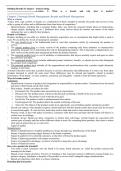Summary
Samenvatting - Building Brand for Impact (EBM073B05)
- Course
- Institution
This document contains a summary of all the course materials discussed in the course Building Brands for Impact which is part of the master Marketing Management at the Rijksuniversiteit Groningen. The summary contains the needed book chapters, information from all the lectures and also a summary of...
[Show more]



